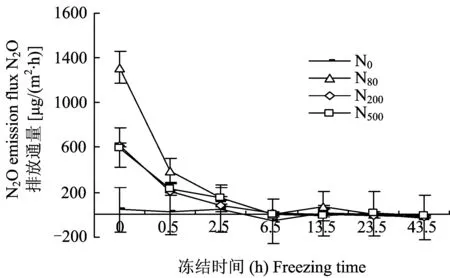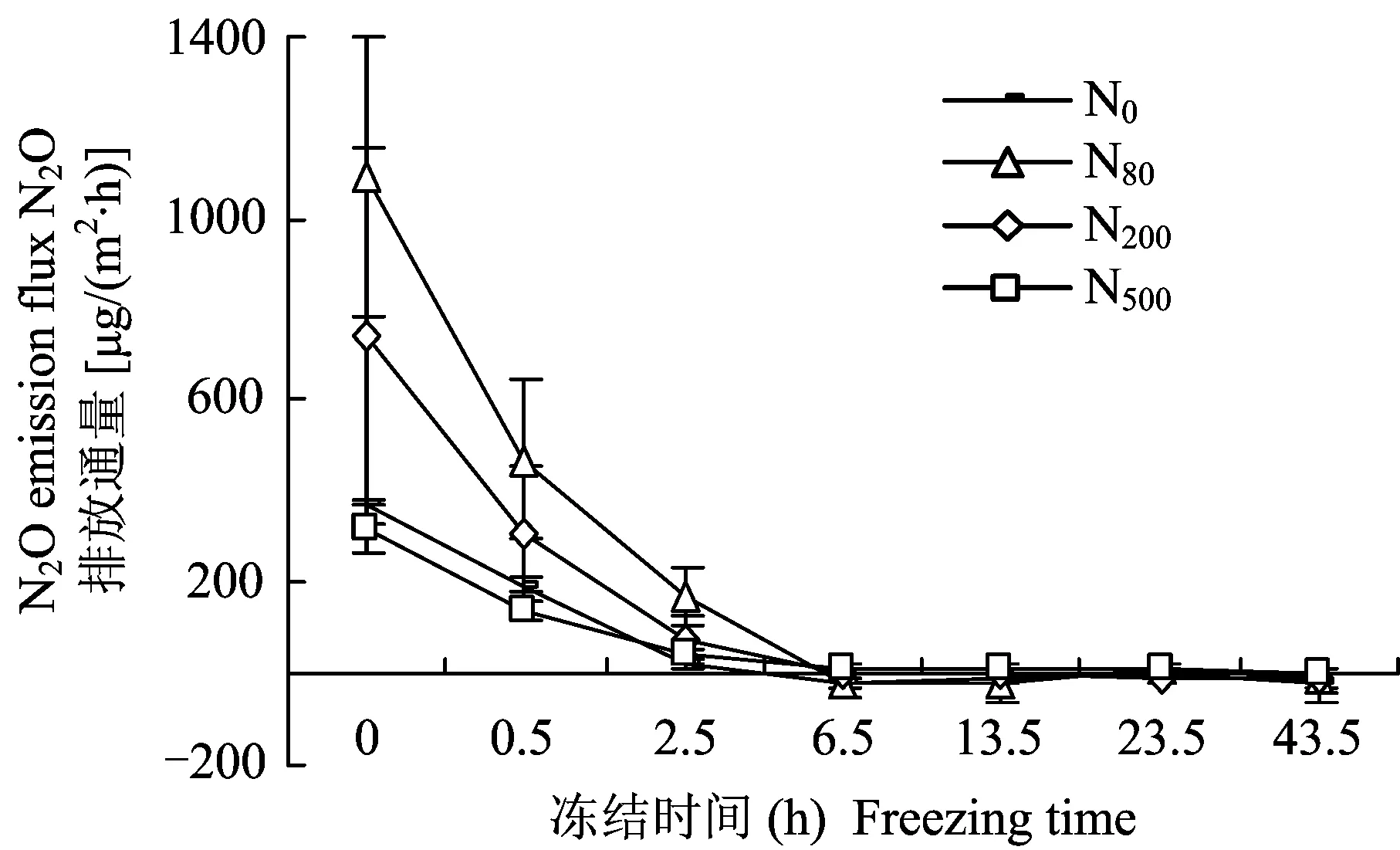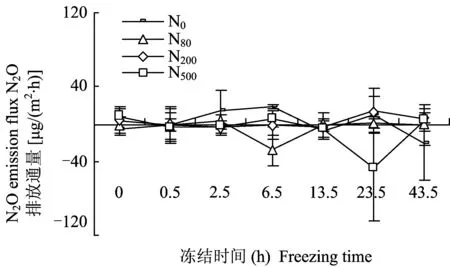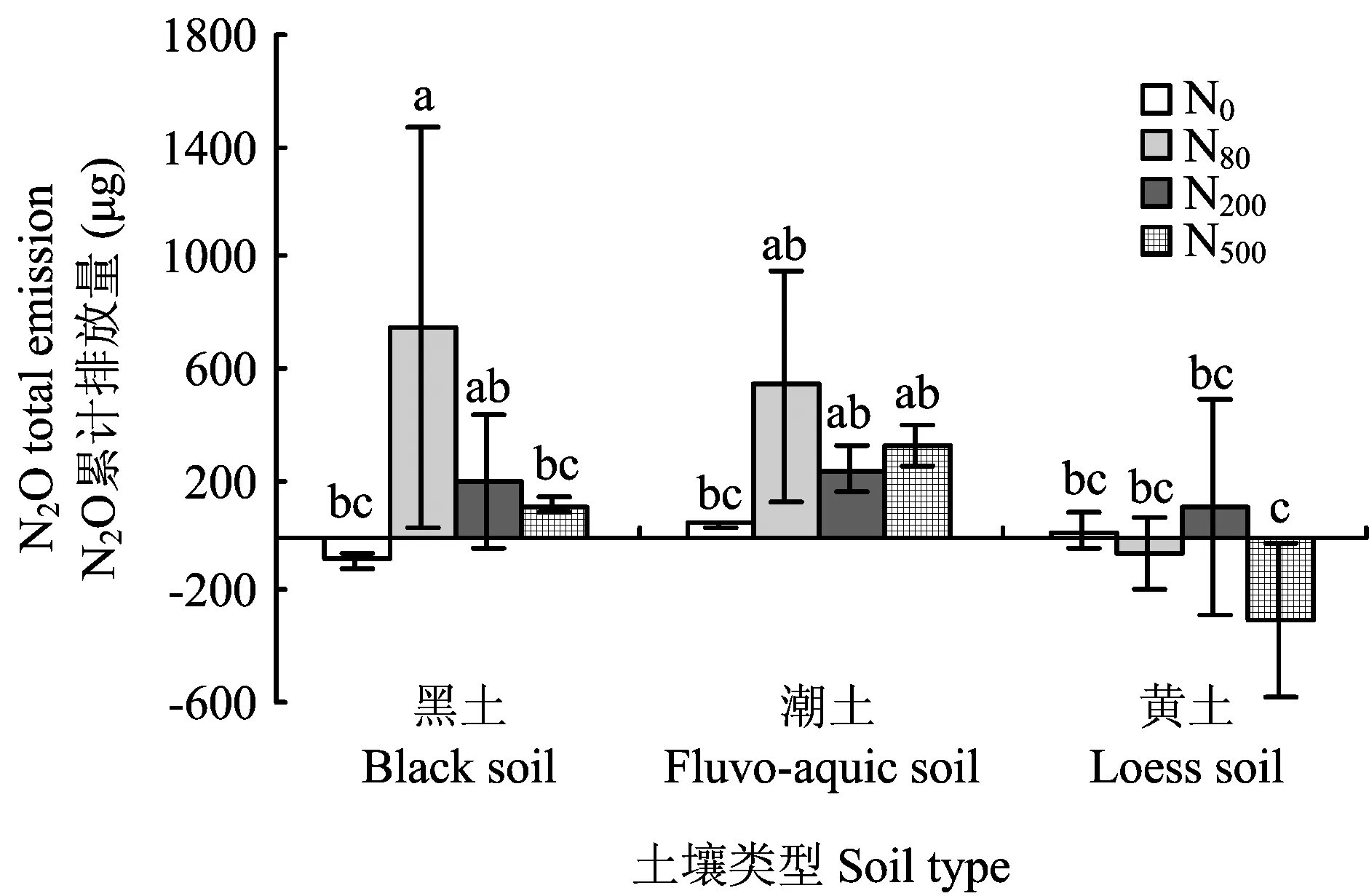外源铵态氮对典型耕作土壤冻结过程中N2O排放的影响
2015-06-15张克强沈仕洲徐宁彤
陈 思, 张克强, 沈仕洲, 王 风*, 徐宁彤
(1东北农业大学资源与环境学院,黑龙江哈尔滨 150030; 2农业部环境保护科研监测所,天津 300191)
外源铵态氮对典型耕作土壤冻结过程中N2O排放的影响
陈 思1,2, 张克强2, 沈仕洲2, 王 风2*, 徐宁彤1*
(1东北农业大学资源与环境学院,黑龙江哈尔滨 150030; 2农业部环境保护科研监测所,天津 300191)

耕作土壤;冻结过程;铵态氮;N2O;排放通量

1 材料与方法
1.1 试验材料

1.2 试验设计

1.3 试验方法

1.4 样品采集及分析
将加入氯化铵溶液的广口瓶开盖置于恒温25℃环境中培养24 h,使水分和氮素在土样中分布达到平衡,并恢复微生物活性。采集气体时将瓶盖盖严后开始计时,分别在0、10、20、30分钟用注射器采集1 mL气体样品,把采集好的注射器针头扎入橡胶垫中以保持气体密封。准备与冰柜内部底面积相同大小的苯板,在苯板上挖出与广口瓶底面积相同的孔洞,将广口瓶口放入孔洞内,并使广口瓶四周与苯板以及苯板四周与冰柜紧密接触以维持广口瓶内土样的冷冻状态。根据3种土壤所在地区的气温调节冰柜为-10℃。分别在冷冻0.5 h、2.5 h、6.5 h、13.5 h、23.5 h、43.5 h时盖上广口瓶盖子取样,气体采集方法同上。气体采集完成后立即用安捷伦5890气相色谱仪检测N2O气体浓度。测定条件为:柱温40℃,转化器温度300℃,63Ni电子捕获器(ECD)检测器温度为320℃,进样量为1 mL,载气为95%Ar与5%CH4混合气,流速为20 mL/min。色谱柱为80/100目PorapakQ的填充柱。

表1 3种土壤的基本理化性状
N2O气体排放通量Flux[11]的计算公式为
Flux = ρ×V×ΔC/Δt×273/[A×(273+T)]
式中:ΔC/Δt 表示时间间隔为Δt时的N2O浓度变化量;ρ为标准状态下N2O气体密度;V和A分别为广口瓶中空气体积和底面积;T为采样时广口瓶内的温度。
试验数据用Excel 2003进行处理,用SAS 9.0软件进行方差分析和Duncan’s新复极差比较。
2 结果与分析
2.1 外源铵态氮对冻结过程中黑土N2O排放通量的影响
2.2 外源铵态氮对冻结过程潮土N2O排放通量的影响

图1 不同浓度外源-N对黑土冻结过程中N2O的排放通量的影响Fig.1 N2O fluxes from the black soil amended with-N during the freezing process

图2 不同浓度外源-N对潮土冻结过程中N2O排放通量的影响Fig. 2 N2O fluxes from the Fluvo-aquic soil amended with -N during the freezing process
2.3 外源铵态氮对冻结过程中黄土N2O排放通量的影响


图3 不同浓度外源-N对黄土冻结过程中N2O排放通量的影响Fig.3 N2O fluxes from the Loess soil amended with-N during the freezing process
2.4 外源铵态氮对冻结过程中3种土壤N2O累计排放量的影响
从图4可以看出,室温—冻结全过程黑土和潮土N2O累计排放量均呈N80> N200、N500>N0。黑土的N80处理N2O累计排放量与N0处理间有显著差异,潮土N80处理的N2O累计排放量高于其它处理,但差异不显著,表明一定含量范围内添加外源铵态氮能够促进黑土和潮土N2O的累计排放量,而外源铵态氮浓度过高会导致N2O累计排放量降低,因此N500处理的N2O累计排放量与N200处理之间均无显著差异。添加外源铵态氮黄土的N2O累计排放量处于较低水平或呈负排放状态,其中N500处理的N2O累计负排放量最大,但与其他处理间的差异并不显著。

图4 外源-N对冻结过程中3种土壤N2O累计排放量的影响Fig.4 Total N2O emissions from Black, Fluvo-aquic and Loess soils amended with -N during the freezing process[注(Note): 柱上不同字母表示处理间差异达5% Different letters above the bars mean significant among treatments at the 5% levels.]
3 讨论

随冻结时间的延长,黑土和潮土N2O排放通量逐渐降低,因为本来受外源铵态氮添加而激发的硝化反硝化微生物活性在持续低温胁迫下会逐渐降低[20]。N2O排放通量降低速度随冻结的持续进行而逐渐变缓也表明了是一个生物学主导过程。有研究表明,黑土微生物经过长期低温环境的选择,微生物细胞对低温产生的适应机理能够快速完成细胞质浓缩,使细胞处于休眠状态,降低冷冻危害[8],在室温条件下较高的N2O排放通量(N80处理)较其他处理排放时间持续更长,如潮土的N80处理N2O排放比N500处理晚4 h(分别在冻结6.5 h和2.5 h)达到稳定状态(0排放),这与王风等[21]的研究结果一致,表明微生物活性在逆境胁迫下是逐渐降低的,需要一个长时间过程才能够达到新的稳定平衡状态[22-23]。黄土N2O排放通量在冻结过程中始终维持较低的或零排状态,仍然是由土壤本身的理化性质所决定的,此外添加外源铵态氮可能会更加剧土壤有机碳不足的矛盾,甚至在冻结过程中出现N2O负排放现象[24-25]。
室温—冻结过程中黑土和潮土的N2O累计排放量趋势一致,在一定范围内增加外源铵态氮能够促进N2O的累计排放量,过量的外源铵态氮又抑制了土壤N2O累计排放量,可能与铵态氮对土壤微生物活性的抑制作用有关[16]。 黄土N2O累计排放量处于较低水平或负排放状态,主要是由土壤理化性质所决定,特别是微生物活性在较低有机碳供给条件下明显地会受到抑制[26-27]。
4 结论
1) 室温条件下,在一定范围内添加外源铵态氮使黑土和潮土的N2O的排放通量显著增加,但过高浓度的外源铵态氮会抑制N2O的排放;随冻结的持续进行添加外源铵态氮黑土和潮土的N2O排放通量逐渐降低,且降低的速度逐渐变缓;随冻结的持续进行N2O排放通量最终接近零排放,但室温时N2O的排放通量高的处理达到稳定零排放速率的时间有向后延长的趋势。

3) 添加外源铵态氮对室温—冻结过程不同土壤类型N2O累计排放量的影响显著。从控制土壤N2O排放的角度来讲,潮土和黑土在越冬前应尽量降低土壤铵态氮肥的浓度,黄土无需考虑铵态氮肥的施用浓度。
[1] Masood E. Obstacles to an agreement[J]. Nature, 1997, 390: 220-220.
[2] 黄莹, 李雅颖, 姚槐应. 强酸性茶园土壤中添加不同肥料氮后N2O释放量变化[J]. 植物营养与肥料学报, 2013, 19(6): 1533-1538. Huang Y, Li Y Y, Yao H Y. Effect of different nitrogen fertilizers on N2O emissions in a highly acid tea orchard soils[J]. Journal of Plant Nutrition and Fertilizer, 2013, 19(6): 1533-1538.
[3] Wuebbles D J. Nitrous oxide no laughing matter[J]. Science, 2009, 326(5949): 56-57.
[4] Denman K L, Fahey D W, Forster Petal. Contribution of working group II to the fourth assessment report of the intergovernmental panel on climate change[M]. Cambridge: Cambridge University Press, 2007. 499-587.
[5] Thomson A J, Giannopoulos G, Pretty Jetal. Biological sources and sinks of nitrous oxide and strategies to mitigate emissions[J]. Philosophical Transactions of the Royal Society B, 2012, 367: 1157-1168.
[6] 伍星, 沈珍瑶. 冻融作用对土壤温室气体产生与排放的影响[J]. 生态学杂志, 2010, 29(7): 1432-1439. Wu X, Shen Z Y. Effects of freezing thawing cycle on greenhouse gases production and emission from soil: A review[J]. Chinese Journal of Ecology, 2010, 29(7): 1432-1439.
[7] 王风, 高尚宾, 张克强, 等. 冻融条件下土壤N2O排放研究进展[J]. 生态环境学报, 2009, 18(5): 1933-1937. Wang F, Gao S B, Zhang K Qetal. Progress on N2O emission from soil in the freeze-thaw process[J]. Ecology and Environmental Sciences, 2009, 18(5): 1933-1937.
[8] 杨思忠, 金会军. 冻融作用对冻土区微生物生理和生态的影响[J]. 生态学报, 2008, 28(10): 5066-5074. Yang S Z, Jin H J. Physilogical and ecological effect of freezing and thawing processes on microorganisms in seasonally-froze of ground and in permafrost[J]. Acta Ecologica Sinica, 2008, 28(10): 5066-5074.
[9] Teepe R, Vor A, Beese Fetal. Emissions of N2O from soils during cycles of freezing and thawing and the effects of soil water, texture and duration of freezing[J]. European Journal of Soil Science, 2004, 55: 357-365.
[10] Burton D L, Beauchamp E G. Denitrification rate relationship with soil parameters in the field[J]. Communications in Soil Science and Plant Analysis, 1985, 16: 539-549.
[11] Yang L F, Cai Z C. The effect of growing soybean(Glycinemax. L.) on N2O emission from soil[J]. Soil Biology and Biochemistry, 2005, 37(6): 120-129.
[12] Chen Y, Tessier S, Mackenzie A Fetal. Nitrous oxide emission from an agricultural soil subjected to different freeze-thaw cycles[J]. Agriculture, Ecosystems and Environment, 1995, 55: 123-128.
[13] 郑殷恬, 赵红. 黑土栗钙土和潮土胡敏酸分子结构的差异性分析[J]. 土壤, 2011, 43(25): 804-808. Zheng Y H, Zhao H. Molecular structure differences of humic acid in black soil, chestnut soil and fluvo-aquic soil[J]. Soils, 2011, 43(25): 804-808.
[14] Steve B, Léveillé R, Pollard W Hetal. Microbial ecology and biodiversity in permafrost[J]. Extremophiles, 2006, 10(4): 259-267.
[15] 杨黎, 王立刚, 李虎, 等. 基于DNDC模型的东北地区春玉米农田固碳减排措施研究[J]. 植物营养和肥料学报, 2014, 20(1): 75-86. Yang L, Wang L G, Li Hetal. Modeling impacts of alternative farming management practices on carbon sequestration and mitigating N2O emissions from spring maize fields[J]. Journal of Plant Nutrition and Fertilizer, 2014, 20(1): 75-86.
[16] 何亚婷, 齐玉春, 董云社, 等. 外源氮输入对草地土壤微生物特性影响的研究进展[J]. 地球科学进展, 2010, 25(8): 965-973. He Y T, Qi Y C, Dong Y Setal. Advances in the influence of external nitrogen input on soil microbiological characteristics of grassland ecosystem[J]. Advances in Earth Science, 2010, 25(8): 965-973.
[17] 陈宝明. 施氮对植物生长、硝态氮累积及土壤硝态氮残留的影响[J]. 生态环境, 2006, 15(3): 630-632. Chen B M. Effect of N supply on plant growth, nitrate accumulation and soil nitrate residue[J]. Ecology and Environment, 2006, 15(3): 630-632.
[18] Crawford L D, Crawford L R, Funk B Setal. Biological isolates for degrading nitroaromatics and nitramines in water and soils[P]. US: 5455173A. 1995-10-03.
[19] 方晰, 田大伦, 项文华. 杉木人工林林地土壤CO2释放量及其影响因子的研究[J]. 林业科学, 2005, 41(2): 1-7. Fang X, Tian D L, Xiang W Hetal. Soil CO2release rate and its effect factors in Chinese Fir Plantation[J]. Scientia Silvae Science, 2005, 41(2): 1-7.
[20] Tourna M, Freitag T E, Nicol G Wetal. Growth, activity and temperature responses of ammonia-oxidizing archaea and bacteria in soil microcosms[J]. Environmental Microbiology, 2008, 10: 1357-1364.
[21] 王风, 白丽静, 张克强, 等. 氮素调控对冻融过程中土壤N2O排放的影响[J]. 环境科学, 2009, 30(11): 3142-3145. Wang F, Bai L J, Zhang K Qetal. Effects of nitrogen application on N2O flux from Fluvo-aquic soil subject to freezing and thawing process[J]. Environmental Science, 2009, 30(11): 3142-3145.
[22] Holtan-Hartwig L, Dorsch P, Bakken L R L. Low temperature control of soil denitrifying communities: kinetics of N2O production and reduction[J]. Soil Biology and Biochemistry, 2002, 34: 1797-1806.
[23] Mazur P. Cryobiogy: the freezing of biological system[J]. Science, 1970, 168: 939-949.
[24] Wu D M, Dong W X, Oenema Oetal. N2O consumption by low-nitrogen soil and its regulation by water and oxygen[J]. Soil Biology and Biochemistry, 2013, 60: 165-172.
[25] Reinhard W, Irina K, Valentin L Getal. Isotopomer signatures of soil-emitted N2O under different moisture conditions-A microcosm study with arable loess soil[J]. Soil Biology and Biochemistry, 2006, 38(9): 2923-2933.
[26] 李贵桐, 李保国, 黄元仿. 碳源与底物对不同层次土壤产生N2O 能力的影响[J]. 土壤与环境, 2002, 11(3): 227-231. Li G T, Li B G, Hang Y F. Effects of carbon and substrate on the N2O productivity of different soil layers[J]. Soil and Environmental Sciences, 2002, 11(3): 227-231.
[27] 陈思, 张克强, 麻晓越, 等. 外源硝态氮对典型性耕作土壤冻结过程N2O排放的影响[J]. 环境科学研究, 2014, 27(6): 635-641. Chen S, Zhang K Q, Ma X Yetal. Effects of nitrate nitrogen application on N2O emission from three types of soils during freezing process[J]. Research of Environmental Sciences, 2014, 27(6): 635-641.
Effects of ammonium-N application on N2O emission from three types of soils in freezing process
CHEN Si1, 2, ZHANG Ke-qiang2, SHEN Shi-zhou2, WANG Feng2*, XU Ning-tong1*
(1DepartmentofAgriculturalResourcesandEnvironments,NortheastAgriculturalUniversity,Harbin150030,China;2Agro-EnvironmentalProtectionInstitute,MinistryofAgriculture,Tianjin300191,China)

cultivated soil; freezing process; ammonium nitrogen; N2O; flux
2013-12-16 接受日期: 2014-04-26
国家自然科学基金项目(41001043);天津市自然科学基金项目(13JCQNJC08400)资助。
陈思(1989—),女,黑龙江友谊县人,硕士研究生,主要从事土壤温室气体排放机制研究。E-mail: shenshenbian@163.com * 通信作者 E-mail: wangfeng_530@163.com; xuningtong000@163.com
S153.6+2;X131
A
1008-505X(2015)03-0608-07
